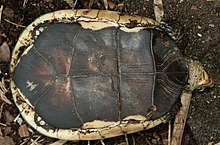Chinese box turtle
| Yellow margined box turtle | |
|---|---|

| |
| Ryukyu Box turtle Cuora flavomarginata evelynae | |
| Scientific classification | |
| Kingdom: | |
| Phylum: | |
| Class: | |
| Order: | |
| Suborder: | |
| Superfamily: | |
| Family: | |
| Subfamily: | |
| Genus: | |
| Species: | C. flavomarginata
|
| Binomial name | |
| Cuora flavomarginata | |
| Synonyms | |
| |
The Chinese box turtle is a species of box turtle with several names. Its common names include Chinese box turtle, Snake-eating turtle, Yellow-margined box turtle, and Golden-headed turtle. Taxonomically, it has been called Cistoclemmys flavomarginata, Cuora flavomarginata, and Cyclemys flavomarginata. The Integrated Taxonomic Information System uses Cuora flavomarginata[1].
Anatomy


C. flavomarginata has a highly domed shell, the carapace and plastron of which are a dark brown, excepting a cream-yellow stripe on the vertebral keel. The edge of the plastron is lightly pigmented due to the marginal scutes' and plastral scutes' lighter pigmentation near their edges. The skin on the limbs is brown in color while the top of the head is a pale green. Each side of the head has a yellow line extending from behind the eye backward. The skin beneath the head and between the limbs is a lighter pink-ish color.
The name box turtle refers to C. flavomarginata's ability to bring the plastron to the edges of the carapace. This is enabled by a hinge on the plastron and ligaments connecting the carapace and plastron, which allows for limited movement.
The forefeet have five claws, while the rear have four.
The external difference between male and female C. flavomarginata is slight. Males have a broader tail than females; it is almost triangular in shape.
Distribution
C. flavomarginata is found in Central China: Hunan, Henan, Anhui, Hubei, Chongqing, eastern Sichuan, Zhejiang & Jiangsu provinces (generally along the Yangtze drainage) (see Fong et al. 202). It is also found in Taiwan and Japan, specifically the Ryukyu Islands, Ishigaki, and Iriomote.[2]
Ecology and life history
Trophic ecology
C. flavomarginata is omnivorous and will eat a large variety of foods. "Adults favor earthworms, frozen pinkies (defrosted), snails, slugs, and mealworms. They also eat dry trout chow and moistened dry cat food, canned cat food; fruits including strawberries, bananas, cantaloupe, and papaya; and vegetables including grated carrots, corn on the cob, and squash. Leafy greens are ignored. Invertebrates that the turtles hunt for include June bug (Phyllophaga) larvae and slugs being principal prey."[3]
Systematics and taxonomic history
In 1863, John Edward Gray described the species as Cistoclemmys flavomarginata. It was later moved to Cyclemys, and then to Cuora. Debate continues on whether the species is consistent with Cuora or if it should be classified separately (as Cistoclemmys). Roger Bour and Ren Hirayama have provided evidence that flavomarginata and others are distinct from Cuora, which has been criticised, but not disproved. Therefore, usage of both Cuora and Cistoclemmys have some standing.
Two subspecies have been named:
This species has hybridized with Mauremys japonica in captivity and with female Ryukyu Black-breasted Leaf Turtles in captivity and in the wild.[4]
References
- ^ "ITIS Standard Report Page: Cuora flavomarginata". Integrated Taxonomic Information System. Retrieved 2006-06-07.
- ^ "REPTILIA-Species:'Cuora_SP_flavomarginata'". EMBL Reptile Database. Retrieved 2006-06-07.
- ^ Connor, Michael J (1998). "The Chinese Box Turtle". Retrieved 2006-06-11.
{{cite web}}: Unknown parameter|coauthors=ignored (|author=suggested) (help); Unknown parameter|month=ignored (help) - ^ Buskirk et al. (2005).
Bibliography
- Buskirk, James R.; Parham, James F. & Feldman, Chris R. (2005): On the hybridisation between two distantly related Asian turtles (Testudines: Sacalia × Mauremys). Salamandra 41: 21-26. PDF fulltext
- Fong, J. , Parham, J. F. & Fu, J. (2002): A REASSESSMENT OF THE DISTRIBUTION OF Cuora flavomarginata Gray 1863 ON MAINLAND. CHINA. Russian Journal of Herpetology Vol. 9, No. 1, 2002, pp. 9 – 14.
